Introduction
Welcome to the Infinit.e landing page! This sub-site is intended for integrators, developers, IT staff, technical analysts, researchers and similar roles, who want a technical overview of the platform and technical information about how to install, configure, exploit, integrate, or extend it.
For a higher level view, check out the following links:
In the spirit of the sort of analysis we would like to support, we will provide the remainder of this overview using the "5 Ws".
Who?
We are Ikanow, the developers of Infinit.e, the first Open Source document analysis platform. Our vision is XXX.
Our community forum is here, at Google Groups.
What?
Infinit.e is a scalable framework for collecting, storing, processing, retrieving, analyzing, and visualizing unstructured documents and structured records.
Click on zoom button above to expand
Let's provide some clarification on each of the often overloaded terms used in that previous sentence:
- It is a "framework" (or "platform") because it is configurable and extensible by configuration (DSLs) or by various plug-ins types - the default configuration is expected to be useful for a range of typical analysis applications but to get the most out of Infinit.e we anticipate it will usually be customized.
- Another element of being a framework is being designed to integrate with existing infrastructures as well run standalone.
- By "scalable" we mean that new nodes (or even more granular: new components) can be added to meet increasing workload (either more users or more data), and that provision of new resources are near real-time.
- Further, the use of fundamentally cloud-based components means that there are no bottlenecks at least to the ~100 node scale.
- By "unstructured documents" we mean anything from a mostly-textual database record to a multi-page report - but Infinit.e's "sweet spot" is in the range of database records that would correspond to a paragraph or more of text ("semi-structured records"), through web pages, to reports of 10 pages or less.
- Smaller "structured records" are better handled by structured analysis tools (a very saturated space), though Infinit.e has the ability to do limited aggregation, processing and integration of such datasets. Larger reports can still be handled by Infinit.e, but will be most effective if broken up first.
- By "processing" we mean the ability to apply complex logic to the data. Infinit.e provides some standard "processing", such as extraction of entities (people/places/organizations.etc) and simple statistics; and also the ability to "plug in" domain specific processing modules using the Hadoop API.
- By "retrieving" we mean the ability to search documents and return them in ranking order, but also to be able to retrieve "knowledge" aggregated over all documents matching the analyst's query.
- By "query"/"search" we mean the ability to form complex "questions about the data" using a DSL (Domain Specific Language).
- By "analyzing" we mean the ability to apply domain-specific logic (visual/mathematical/heuristic/etc) to "knowledge" returned from a query.
We refer to the processing/retrieval/analysis/visualization chain as document-centric knowledge discovery:
- "document-centric": means the basic unit of storage is a generically-formatted document (eg useful without knowledge of the specific data format in which it was encoded)
- "knowledge discovery": means using statistical and text parsing algorithms to extract useful information from a set of documents that a human can interpret in order to understand the most important knowledge contained within that dataset.
One important aspect of the Infinit.e is our generic data model. Data from all sources (from large unstructured documents to small structured records) is transformed into a single, simple. data model that allows common queries, scoring algorithms, and analytics to be applied across the entire dataset. The following diagram (click zoom to expand) illustrates this:
| There are no images attached to this page. |
The following thumbnails (click to expand) show a complex query being built, and an examples of visualizing the knowledge encoded in documents returned from the query. Note that although the screenshots show our webapp being used, in practice the Infinit.e platform can be integrated with any open front-end application or analytical chain.
TODO order these, annotate, remove Tim's name
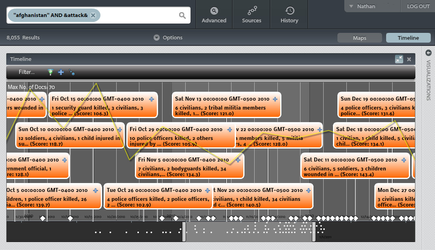
|
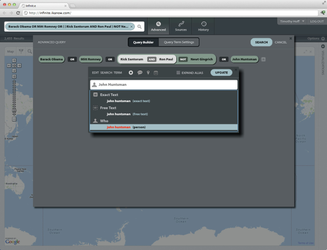
|
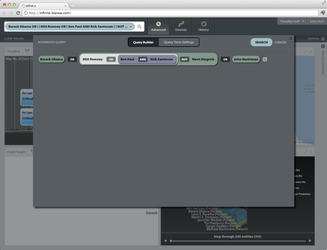
|
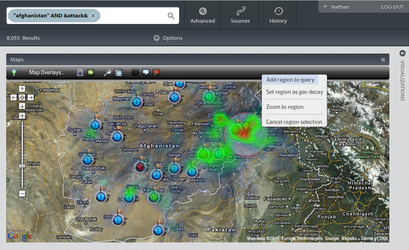
|
|
4. Temporal document view
|
2. People suggestions
|
1. A complex boolean query
|
3. Individual and aggregate geotags
|
Why...
... did we build it?
While supporting information analysts for the military and Government, we observed that the landscape of professional analysis tools is dominated by expensive proprietary products with limited flexibility, vendor lock-in, and requiring extensive and continuing customization by expensive consultants.
Further, these tools had often originally been designed to analyze and mine structured records, whereas increasingly data is generated in a mix of unstructured documents and traditional structured records. Usually, unstructured documents dominate structured records in terms of readily available intelligence to be gleaned.
So we believed there was a gap in the market, if it could be filled.
We also observed that the Open Source community was developing tools that provided many of the core functions needed for an unstructured document-centric analysis tool (storage, search, aggregation, analytic frameworks). This provided some exciting new opportunities:
- To lower the cost of developing an analytic platform, eliminating traditional cost barriers to its use, and freeing effort to focus on domain and analyst specific functionality and process
- To helps the platform remain up-to-date, since the OSS tools are in continuous development and the ecosphere in general is very active.
- Finally, to foster an active open community of developers and users, in the image of the OSS projects on which the platform is built.
Further, the increasing richness and availability of low cost SaaS and PaaS cloud services meant that great functionality, like NLP, and great computing performance scalability using platforms like EC2, were affordably available for smaller organizations.
Based on these needs and opportunities, we built Infinit.e, the first Open Source document analysis cloud platform, using great OSS projects like Lucene, elasticsearch, Hadoop, MongoDB, tomcat, and many others. Our objectives are:
- To provide, maintain, and enhance an "Internet-scale" document analysis platform based on the currently best available mature Open Source projects.
- To continue to develop the functionality based on analyzing and abstracting real users' requirements.
- To make the platform's source available to everyone under standard Open Source licenses.
- To provide a simple but powerful front end to enable and demonstrate the platform's most important capabilities.
- To help organizations customize the tool to align to their existing processes/tradecraft, as well as to take advantage of new opportunities afforded by the tool's functionality.
- To build more focused, smaller scale, applications using modified versions of the platform (eg for performance/scale vs functionality).
| There are no images attached to this page. |
Key OSS and cloud technologies used in Infinit.e
... might you want to use it?
The platform is intended to support any profession where analyzing and synthesizing large volumes of data can TODO.
Specific examples include, but are not limited to:
- Business analysts:
- TODO
- Journalists:
- TODO
- Universities:
- TODO
- Law enforcement analysts:
- TODO
- Military analysts:
- TODO
- Open Source Intel analysts:
- TODO
- Intel analysts:
- TODO
TODO in addition the platform can form the basis of more focused tools to perform . TODO something about "everyone does analysis even if they don't call themselves analysts"
TODO /wiki/spaces/INF/pages/6521453
TODO order these, annotate, remove Tim's name. TODO also not sure what these bring to the table
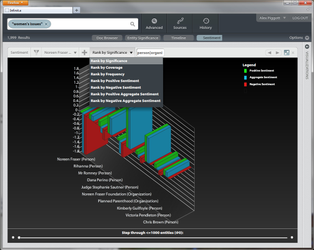
|
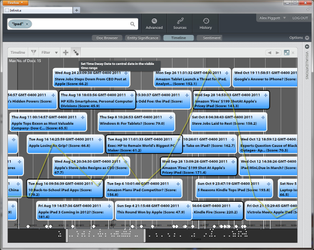
|

|

|
|
5. Sentiment analysis across news and social media
|
6. Business analysis
|
4. A heatmap of DC crime
|
1. Wide variety of sources for Open Source Intelligence
|
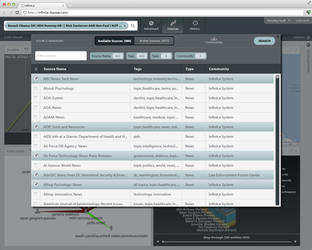
|

|
||
|
2. Separating sources into communities, example blog sources
|
3. A variety of customizable ways to slice the data
|
When?
Starting with prototypes developed at MTCSC (since acquired by Mantech), we started development of the tool in November 2010, focusing on adopting the best OSS tools for the tool's different functions, productionizing their use, and glueing them together in a logical way.
We released the first Open Source version in March 2012, mostly under the Affero GPL license (with plugins and utilities mostly released under the Apache 2.0 license).
Development continues: check out our roadmap.
How...
- ... to learn more about the platform: click here for further details about the architecture, here are some details on our near-term roadmap.
- ... to download and install the platform: click here. TODO
- ... to import data into the tool and perform basic analysis: click here. TODO
- ... to develop and install plugins and visualizations: click here. TODO
- ... to integrate with other platforms: Infinit.e contains a rich and open REST API, described here. The API documentation includes "tutorials" (here) on performing many common operations using the API.
- ... to download and develop core infrastructure: the Open Source repository is here, information about building and developing the code is here. TODO